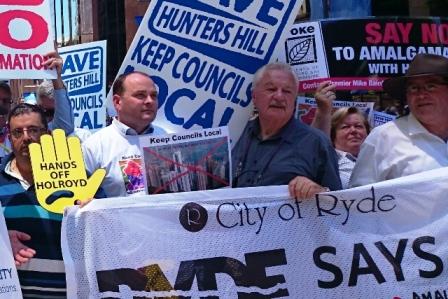
The Greens and the NSW government are waging a numbers war over how many of Sydney’s 41 councils have submitted merger proposals.
The Independent Pricing and Regulatory Tribunal’s (IPART) Fit for the Future report, released last month, declared 87 NSW councils ‘not fit‘ and State Premier Mike Baird ordered rebel councils who had previously opted to stand alone to resubmit merger proposals.
Of these 87 NSW councils deemed not fit by IPART, 29 were in Sydney. Only 12 metropolitan councils made the grade.
Some councils resubmitted merger proposals voluntarily but others made it clear that this was their second choice and applicable only if they were forced to merge.
The NSW government has already underlined that those councils who failed to submit a merger option by last week’s deadline would miss out on state government cash to fund mergers and community infrastructure and may have a weaker voice in any new council formed through amalgamation.
Some councils also feared that they would be pushed into merging with financially shaky neighbours or councils that were not a good fit for other reasons.
NSW Local Government Minister Paul Toole said a “significant number” of NSW councils had lodged merger proposals and confirmed that 22 Sydney councils and 26 regional councils had done so but Greens Local Government spokesman David Shoebridge countered that 31 of Sydney’s 40 councils – or 75 per cent – submitted a first preference to stand alone.
Government News contacted Mr Toole’s office and the Department of Premier and Cabinet, which dealt with last week’s council submissions, but could not get information on how many NSW councils had refused to submit a merger option or how many had listed a merger as their second choice, under duress.
Greens Local Government spokesman David Shoebridge said 19 Sydney councils refused to nominate a preference if forced to merge and 12 “reluctantly indicated” potential merger partners only if compelled.
He labelled the government’s figures “inflated” and said the councils had demonstrated a “wholesale rejection of the government’s bullying agenda.”
“The Baird government continues to fudge the numbers on council amalgamations, with reported claims that more than 20 Sydney councils are volunteering to amalgamate,” Mr Shoebridge said.
“The fact is that these figures just don’t add up and that the overwhelming majority of Sydney councils have submitted a first preference to stand alone and remain genuinely local.”
But Mr Toole said there was “widespread acknowledgement” from councils that they needed to be fit for the future.
“There is real momentum building up among councils that are talking and agreeing to come together,” Mr Toole said.
“It is encouraging that many councils have held discussions with their neighbours and the government about the benefits of merging.”
He said the government would respond to submissions by the end of the year.
Meanwhile, Local Government NSW (LGNSW) President Keith Rhoades said he thought the government was likely to make an announcement about council mergers earlier and perhaps by the end of next week.
“It’s the same process as the last 12 months,” he said. “It’s just been hush hush from government. No information about what the process is, except to say “we don’t know what the process is”.
“They obviously know but they don’t want to tell anyone else!”
LGNSW and UTS’ Centre for Local Government are preparing a toolkit for those councils who have agreed to merge, with advice on governance, financial and operational issues.
Mr Rhoades said: “The policy is this: members that want to voluntarily merge, we are there to help them through the process. If they want to get married to their neighbour, we’re happy to help with the engagement party.”





First piece of factual information re forced amalgamation that I’ve seen emanating from anywhere with the word “Government” in its title
The only winners as a result of amalgamations are the public servants working in the new arrangements.